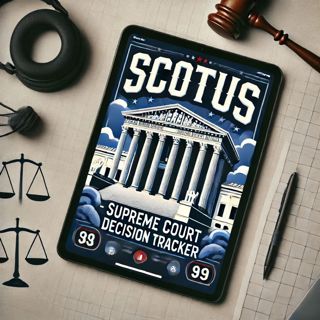
Headline: "Supreme Court's Rulings Reshape Science Funding, Online Privacy, and Workplace Discrimination Laws"
This week, the US Supreme Court has made headlines with several major developments shaping law, policy, and society. Justices most recently issued a narrow 5-4 decision in National Institutes of Health v. American Public Health Association, which leaves over $780 million in NIH grants unavailable. The ruling is already causing a chilling effect in the research community, forcing academic centers and scientists nationwide to reconsider ongoing and future projects. Debate continues about the broader implications for federal science funding, with research advocates arguing that the decision threatens progress and public health while supporters frame it as a necessary check on administrative authority.The court also blocked an emergency appeal aimed at preventing Mississippi's controversial age assurance law from going into effect. This law mandates age verification for users of social networks like Bluesky and Mastodon, forcing companies either to comply with technical requirements or halt service altogether. Critics argue the move compromises online privacy and internet freedom, while supporters say it protects children and better aligns with legislative intent.Justice Alito made news for filing his 2024 financial disclosure, drawing attention to the increased scrutiny of justices’ outside income and investments. Meanwhile, the Supreme Court’s recent employment law rulings made waves in lower federal courts. The Fourth Circuit this week highlighted the impact of Muldrow v. City of St. Louis, a decision in which the Supreme Court broadened the definition of adverse employment action under Title VII. Now, employees can bring discrimination claims for detrimental transfers or other workplace changes even without pay cuts or formal demotions, a shift predicted to trigger more workplace litigation.Looking ahead, listeners should know that the Supreme Court is poised to hear Robinson v. United States, a challenge that could potentially reshape the National Firearms Act and American gun rights. Experts caution that this could be one of the most consequential Second Amendment cases in decades. The future of voting rights also remains a prominent topic, with Erwin Chemerinsky writing about growing uncertainty around electoral protections and Supreme Court doctrine.For those tracking major employer and religious freedom cases from the term, Trump v. CASA imposed new limits on district court injunctions, making it harder for plaintiffs to obtain sweeping orders against federal policies. Catholic Charities Bureau Inc v. Wisconsin Labor and Industry Review Commission clarified that government religious exemptions cannot prefer one faith over another, broadening eligibility for religious organizations and schools.Finally, legal observers and policymakers are dissecting the Court's use of its “shadow docket,” the growing practice of issuing quick, often unsigned decisions that can reverse lower courts or freeze major policy changes overnight. Opinions remain divided about whether this streamlines justice or undermines transparency and trust in the highest court.Thanks for tuning in, and remember to subscribe. This has been a Quiet Please production, for more check out quiet please dot ai.For more http://www.quietplease.aiGet the best deals https://amzn.to/3ODvOtaThis content was created in partnership and with the help of Artificial Intelligence AI
29 Aug 3min

Supreme Court Rulings: Shaping Science, Sparking Debate, and Impacting America's Future
The US Supreme Court has been at the center of several major developments and ongoing legal battles that have captured national attention. Over the past few days, the Court made headlines with a deeply divided decision regarding the National Institutes of Health’s research grant policies. According to analysis by Crowell & Moring and Vinson & Elkins, the Supreme Court issued a split ruling on whether the NIH could terminate certain research grants after a district court previously found that NIH's new guidance on cutting funds for projects related to COVID-19, gender identity, and diversity, equity, and inclusion was “arbitrary and capricious.” The Supreme Court agreed to let NIH’s terminations of research grants stand for now but blocked the agency from enforcing its internal policy guidelines, leaving the future of affected scientific funding in limbo while appellate proceedings continue. Notably, the deciding vote came from Justice Amy Coney Barrett, whose nuanced view split the difference between the conservative and liberal blocs, with each side seeing the procedural questions differently.Looking ahead, several hot-button social issues are moving toward the Supreme Court’s docket. According to SCOTUSblog, the justices are being urged to take up cases, including Colorado’s ban on conversion therapy for minors, whether the Ten Commandments can be displayed in Texas public schools, and a major abortion case that could shape the post-Roe legal landscape. There’s also mounting speculation that questions about former President Trump’s use of emergency economic powers and his attempts to fire a Federal Reserve governor could reach the Court soon, as reported by ABC News and the Atlantic Council, signaling looming battles over executive authority and financial policy.Aside from broader constitutional questions, there are ongoing reverberations from the Court’s decision back in June that reversed a lower court’s block on the Department of Government Efficiency accessing certain Social Security Administration data. This has triggered fresh concerns and a whistleblower complaint, Government Accountability Project reports, about data security and the risk of identity theft for millions of Americans whose information may have been moved to insecure cloud environments in the aftermath of the ruling.The Supreme Court’s recent activities underscore persistent ideological divides, the pivotal power of swing votes in high-stake administrative battles, and the Court’s central role in shaping American governance on issues ranging from scientific research to the economy and social policy. The docket for the coming months is already packed with cases that promise to have nationwide impact—for listeners interested in the intersection of law, policy, and daily life, these developments bear close watching.Thank you for tuning in, and don’t forget to subscribe. This has been a Quiet Please production, for more check out quiet please dot ai.For more http://www.quietplease.aiGet the best deals https://amzn.to/3ODvOtaThis content was created in partnership and with the help of Artificial Intelligence AI
27 Aug 3min

Supreme Court Decision Allows Trump Administration to Cut $783 Million in NIH Research Grants, Impacting DEI Initiatives
In the latest developments from the US Supreme Court, the major headline centers on a sharply divided 5-4 decision that allows the Trump administration to cut $783 million in National Institutes of Health research grants. This move directly targets projects tied to diversity, equity, and inclusion, aligning with efforts to scale back federal support for DEI initiatives. The ruling overturned a lower court’s order that previously blocked the funding cuts, and while Chief Justice John Roberts joined the court’s three liberal justices in dissent, the majority paved the way for the administration’s priorities to take effect. Justice Neil Gorsuch authored a pointed opinion criticizing lower courts for not consistently adhering to Supreme Court emergency orders, a theme that’s growing in prominence as the high court increasingly intervenes to direct outcomes on its emergency docket.Justice Amy Coney Barrett provided a crucial swing vote that retains a block on future anti-DEI directives from the administration, preventing new terminations for now, but current grants remain subject to cancellation. Justice Ketanji Brown Jackson’s dissent expressed deep concern about the court’s willingness to bypass ordinary deliberative processes in these emergency settings, warning of adverse consequences for public health and scientific research. According to expert assessment from Inside Higher Ed and the Association of American Medical Colleges, the decision is considered potentially damaging for research continuity and the broader scientific enterprise. It creates significant uncertainty for scientists whose projects may now be abruptly halted, risking years of data collection and progress. Analysts note the fallout could reverberate across the entire US research ecosystem, especially as further legal challenges will now shift to the Court of Federal Claims, which has more restrictive avenues for addressing grant terminations.Beyond this headline decision, Supreme Court justices continue to express frustration with lower federal courts that have resisted its emergency directives. CNN and legal commentators highlight a growing tension over how lower courts should interpret and apply these expedited orders, some of which come without detailed reasoning and leave trial judges guessing at the intended scope and precedent. The Court has been notably assertive in recent months, siding with the Trump administration in high-profile disputes over federal spending, immigration, and regulatory rollbacks, further cementing its role as a decisive arbiter over executive priorities.Listeners, thanks for tuning in and don’t forget to subscribe for continuing updates on Supreme Court news and more. This has been a Quiet Please production, for more check out quietplease dot ai.For more http://www.quietplease.aiGet the best deals https://amzn.to/3ODvOtaThis content was created in partnership and with the help of Artificial Intelligence AI
25 Aug 2min

Supreme Court Rulings Reshape Voting Rights and Federal Agency Oversight
The Supreme Court has made headlines by pausing an appeals court decision that would have sharply restricted who can bring lawsuits under the 1965 Voting Rights Act. This case revolves around a challenge to North Dakota's redistricting and carries heavy implications for Native American voting rights and enforcement of anti-discrimination provisions across several states. The high court’s pause was backed by civil rights groups and Native American tribes, marking a significant temporary win for private parties, including organizations like the NAACP, who have long used the law to combat racial discrimination in voting. Three conservative justices dissented from the decision, and the case will remain in the spotlight as the two Native American tribes at the center await the next steps in their appeal.In separate developments, the Supreme Court issued a partial stay involving National Institutes of Health (NIH) research grants, making it more challenging for public interest groups to directly contest funding decisions. Public health advocates view this move as a setback, emphasizing the Court’s stance that some federal policies or individual grant cancellations may not be subject to routine judicial review. This ongoing dispute over how NIH funding can be challenged in the courts reflects broader tensions around federal oversight and agency discretion.The Court also recently allowed Mississippi to begin enforcing a new law restricting social media use by children, notably parental consent and age verification requirements. Although a First Amendment challenge to the law is ongoing, the justices declined to block enforcement at this time, signaling a willingness to let state regulations on children’s online activity proceed while challenges move through lower courts.Analysis by The Regulatory Review points out that these decisions, among others, fit into a larger pattern under the current Supreme Court of expanding presidential authority, including bolstering the President’s power to remove leaders of independent agencies. Legal scholars warn that this shift could undermine the traditional checks and balances that have defined constitutional governance.Listeners should also watch for the Supreme Court’s upcoming handling of Louisiana’s congressional map, which raises fresh issues around racial gerrymandering and the Voting Rights Act. The justices have still not resolved the case and are set to revisit arguments next term, keeping redistricting and civil rights at the top of the national legal agenda.Thanks for tuning in and don’t forget to subscribe. This has been a quiet please production, for more check out quiet please dot ai.For more http://www.quietplease.aiGet the best deals https://amzn.to/3ODvOtaThis content was created in partnership and with the help of Artificial Intelligence AI
24 Aug 2min

Supreme Court Upholds Trump Admin's Cuts to Diversity Research Funding
Listeners, here’s the latest major news involving the US Supreme Court over the past few days. The most significant headline centers on the court’s decision allowing the Trump administration to cut hundreds of millions of dollars in federally funded research, specifically targeting projects tied to diversity, equity, and inclusion (DEI) initiatives. According to reporting from the Associated Press and SCOTUSblog, the justices voted 5-4 in favor of lifting a lower court order that had blocked $783 million in cuts from the National Institutes of Health. This means the administration can proceed with canceling numerous grants, although the court has kept future guidance on funding blocked for now.Justices who opposed the cuts, including Chief Justice John Roberts and Justice Ketanji Brown Jackson, expressed strong concerns. Justice Jackson, in a detailed dissent, criticized the court’s emergency decision-making and warned of severe consequences for public health and scientific progress, arguing that canceling research projects mid-stream risks "incalculable losses in public health and human life." Meanwhile, the administration defended its actions, arguing that federal funding decisions should not be second-guessed by courts and that DEI policies can sometimes mask discriminatory practices.The decision is viewed as another significant win for the Trump administration’s broader effort to reshape federal policy on DEI and executive authority. In another related case, the Supreme Court recently reinforced the power of the president to remove certain federal officials, citing a separate decision that expanded presidential authority over the National Labor Relations Board.There are other notable developments on the court’s docket. SCOTUSblog highlights two upcoming cases in the new term that could have far-reaching implications for the sports world and the potential for the justices to review and possibly overturn some longstanding judicial precedents. Several upcoming cases are also drawing attention, involving gun rights and questions about religious displays in public schools, with federal courts blocking Texas's attempt to require the Ten Commandments in every classroom.Overall, the tone at the court remains contentious, marked by ideological divides and debates over the boundaries of presidential power, racial discrimination, and civil rights. Listeners should expect the Supreme Court to remain in the headlines, as the justices continue to weigh in on issues with major impacts for law, policy, and society.Thank you for tuning in, and don’t forget to subscribe for more Supreme Court updates. This has been a Quiet Please production; for more, check out quietplease.ai.For more http://www.quietplease.aiGet the best deals https://amzn.to/3ODvOtaThis content was created in partnership and with the help of Artificial Intelligence AI
22 Aug 2min

Supreme Court's 2025-26 Term: High-Stakes Battles Ahead for Sports, Privacy, and Civil Rights
The US Supreme Court is entering a significant phase as it prepares for its 2025-26 term, with several high-profile cases already on the docket. SCOTUSblog reports that the justices are set to hear two major sports-related cases: Little v. Hecox and West Virginia v. B.P.J. Both will address whether state laws that bar transgender athletes from participating on girls’ and women’s sports teams violate the 14th Amendment’s equal protection clause or Title IX, a cornerstone of civil rights law in federally funded education. These cases are drawing national attention for their potential impact on athletics and legal interpretations of gender and equality.In addition to these, the court may soon decide whether to hear National Basketball Association v. Salazar, a case revolving around data privacy and the Video Privacy Protection Act. The NBA is contesting a lower court ruling regarding the alleged improper sharing of user video viewing data with third parties like Meta, the parent company of Facebook. The outcome could have implications for every major sports league’s digital operations and for consumer data protections more broadly.There has also been continued fallout from previous Supreme Court decisions on sports betting. Since the Court’s 2018 ruling striking down a federal ban, sports betting is now legal in 38 states and has rapidly become a massive industry, with nearly $150 billion in wagers processed in 2024 alone, according to the American Gaming Association and the National Conference of State Legislatures, as shared by SCOTUSblog.On the environmental and indigenous rights front, the Supreme Court remains a topic of interest in the Oak Flat dispute, where Apache groups and environmental activists continue to challenge a pending land exchange that would allow for a massive copper mine on sacred ground in Arizona. Although a federal appeals court has recently paused the land exchange, there is speculation among legal commentators and reporting from sources like Global Sisters Report that the Supreme Court could eventually be asked to weigh in on religious freedom aspects of the case, given its long legal history and widespread public interest.Meanwhile, legal developments in California are attracting the Supreme Court’s attention around arbitration law and business regulation. Legal news sources such as DLA Piper have explained that the California Supreme Court recently upheld — but significantly narrowed — a state law requiring employers to pay arbitration fees promptly or risk losing the right to compel arbitration. While the decision means businesses won’t face automatic forfeiture for every late payment, the future of such state-level arbitration laws remains uncertain, with many watching for possible Supreme Court review to settle questions about federal preemption and contract law.Current discussions and speculation in legal circles, as seen on SCOTUSblog and other outlets, are focusing on whether the Supreme Court will grant review in cases over gun regulation, labor arbitration, and digital privacy in the coming weeks. Court-watchers emphasize that deliberations from the justices during the so-called “long conference” could set the tone for what promises to be another pivotal term for legal doctrine in civil rights, technology, and public policy.Thanks for tuning in, and don’t forget to subscribe. This has been a Quiet Please production, for more check out quiet please dot ai.For more http://www.quietplease.aiGet the best deals https://amzn.to/3ODvOtaThis content was created in partnership and with the help of Artificial Intelligence AI
20 Aug 3min

Supreme Court Upholds Mississippi's Social Media Law for Minors
The Supreme Court just made waves by allowing Mississippi to continue enforcing its new restrictions on children’s access to social media while the legal challenge brought by NetChoice, a tech industry group representing giants like Meta and YouTube, moves forward. This law, House Bill 1126, requires minors to obtain parental consent before creating social media accounts and places strict obligations on platforms to verify user ages and shield kids from harmful content, with the threat of steep civil and criminal penalties. In an unsigned order, the justices declined to block the law for now, despite a lower court finding that it likely violates the First Amendment. Justice Kavanaugh sided with the majority, stressing that the law remains probably unconstitutional but that the Court would wait to weigh in until lower courts issue a more detailed analysis. Many legal observers see this as a signal that the justices are not eager to intervene in the ongoing policy battles over regulating youth online access and social media harms.Another significant development is the continuing fallout from the Trump v. CASA, Inc. decision, where the Court notably limited federal judges’ ability to issue nationwide injunctions. This ruling means federal courts must now stick to remedies tailored to the parties in a given case, ending the widespread use of universal injunctions that have been favored in hot-button cases, including recent battles over immigration policy and executive orders. As explained by a summary on Restructuring Globalview, the Court leaned on historical legal traditions and the limits of the Judiciary Act of 1789, emphasizing that only class actions conducted under the Federal Rules of Civil Procedure can truly offer broad relief.Legal observers are also still digesting the transformative impact of last year’s Loper Bright Enterprises v. Raimondo ruling, which overturned the 40-year-old Chevron doctrine. That doctrine had compelled courts to defer to federal agency interpretations of ambiguous statutes, but the new stance from the Supreme Court is that courts themselves must determine the single best reading of congressional statutes, reducing the power of agencies to adapt policies in shifting political climates. According to KL Gates, this shake-up has sent shockwaves through administrative law, as regulated industries and government lawyers scramble to adapt to a post-deference world.Meanwhile, briefs continue to land before the justices in major disputes. CAC notes that the Supreme Court is considering whether judges can grant compassionate release based on their discretion, even if the original sentencing didn’t allow for it, in Fernandez v. United States. Also pending is a case testing if police can enter a home without a warrant on less than probable cause during suspected emergencies, stemming from an incident in Montana where police forcibly entered a home and shot a resident.Listeners should also be aware of the broader federal court battles that could soon reach the Supreme Court. These involve everything from federal funding freezes on infrastructure projects to the termination of grant programs under new presidential administration priorities, with lawsuits filed challenging the legality and constitutionality of these terminations.Thanks for tuning in, and don’t forget to subscribe for more updates. This has been a quiet please production, for more check out quiet please dot ai.For more http://www.quietplease.aiGet the best deals https://amzn.to/3ODvOtaThis content was created in partnership and with the help of Artificial Intelligence AI
15 Aug 3min

Supreme Court Ruling Limits Nationwide Injunctions, Reshapes Civil Rights Landscape
Listeners, here’s the latest from the United States Supreme Court. The biggest headline from recent days is the fallout from Trump v. CASA, Inc., the birthright citizenship case. The Supreme Court did not make a ruling about who qualifies as a citizen, but instead put an end to the widespread use of nationwide injunctions by federal trial courts. These universal injunctions had allowed a single plaintiff to halt a government policy across the country almost instantly. With the Court’s ruling, judges can now only grant relief to plaintiffs who are parties to a case, so anyone else affected must bring their own lawsuit or join a class action. Justice Brett Kavanaugh emphasized that class actions and suits under the Administrative Procedure Act remain pathways for broader relief, and, in fact, civil rights attorneys responded immediately by filing a nationwide class-action suit that quickly led to a preliminary injunction blocking the Trump administration’s executive order restricting birthright citizenship for all affected children. The government is expected to appeal, and listeners should expect more litigation and perhaps a return to the Supreme Court for a final decision.Marriage equality is also back in focus, as Kim Davis, the former Kentucky clerk who refused to issue marriage licenses to same-sex couples, has asked the Supreme Court to reconsider its landmark 2015 ruling in Obergefell v. Hodges, which legalized same-sex marriage nationwide. Legal experts believe her case is extremely narrow and unlikely to unsettle existing precedent, as the lower courts have consistently denied her arguments and there is broad consensus that the core ruling will stand.In the background, another major point of tension is the Supreme Court being asked to weigh in on whether immigration agents can use racial profiling—part of broader challenges to the Trump administration’s policies at the intersection of civil rights and immigration enforcement. At the same time, the Court is expected to soon consider a Second Amendment case with drug law implications, which could shape how firearms restrictions intersect with other federal laws.Finally, listeners should know that the Supreme Court’s latest moves are causing ripple effects beyond just headline cases. Advocacy organizations and legal commentators continue to debate the impact of strictly limiting court orders to plaintiffs rather than the whole country, including what it means for civil rights, business, and government policy, as well as concerns about “shadow docket” decisions and emergency relief processes.Thank you for tuning in. Don’t forget to subscribe for more in-depth Supreme Court updates. This has been a quiet please production, for more check out quiet please dot ai.For more http://www.quietplease.aiGet the best deals https://amzn.to/3ODvOtaThis content was created in partnership and with the help of Artificial Intelligence AI
13 Aug 2min





















